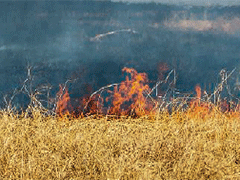March 14, 2017
Kansas Forest Service and K-State Research and Extension Agents Help Lead Fire Response Across the State
Submitted by Jennifer Williams

Fires sped across Kansas last week, killing anywhere from 3,000 to 9,000 head of cattle, as well as wildlife, and forcing road closures and community evacuations. More than 700,000 acres have burned in 21 counties.
An Oklahoma truck driver died March 6 in Clark County because of smoke inhalation, and red-flag warnings for high winds remained through much of the week. Gov. Sam Brownback declared a state of disaster emergency to expedite emergency response assistance to affected counties, and the Kansas Division of Emergency Management coordinated state response operations from a round-the-clock operations center in Topeka. State Forester Larry Biles traveled to Hutchinson March 7 to welcome the Rocky Mountain Incident Management Blue Team, which was called into Kansas to assist with firefighting efforts. That crew is a type 2 interagency Incident Management Team that comes together to manage all-hazard emergency incidents. The team comprises fire and emergency professionals from state, local and federal land management agencies and emergency agencies.
All Kansas Forest Service fire staff members, as well as temporary fire personnel, were fully engaged in the multiple fires around the state, assisting with incident management teams in Clark, Ford and Reno county areas as well as coordinating incoming aircraft and strike teams.
Key fire-control personnel were dispersed across the areas of need: Fire Planning Specialist Eric Ward was in Dodge City; Fire Training Specialist Rodney Redinger in Hutchinson; Fire Program Coordinator Ross Hauck in Ashland; and Fire Protection Specialist Jason Hartman assisted at the State Emergency Operations Center in Topeka. Kansas Forest Service district 8 forester, John Klempa acted as a Single Engine Air Tanker (SEAT) manager, which involved being the ground contact for making sure that the SEATs had what they needed logistically and could operate safely, and he coordinated between the pilots and the incident command structure on what needed to be done. SEATs carry up to 800 gallons of water to the fire quickly and drop it on the fire line, or ahead of the fire line in a protective manner. Their drop altitude and approach is similar to an agriculture "crop duster" type aircraft. Kansas Forest Service district 6 forester, Dennis Carlson, acted as Engine Boss, in charge of KFS wildland fire engine 62 apparatus and crew, similar to a municipal Fire Department Captain. He received assignments from the command structure and was responsible for deciding how best to accomplish those tasks safely and efficiently. In this capacity, the Engine Boss will be at times directly on the fire line supervising his crew of firefighters to attack the fire and protect structures. Numerous Kansas Forest Service full time and temporary employees filled roles ranging from finance to meteorology, mapping, as well as physical firefighting efforts. The long hours spent coordinating resources from across the country, responsibility of split-second decision making that impacted the lives and property of the public, and time spent away from their own families is recognized and truly appreciated.